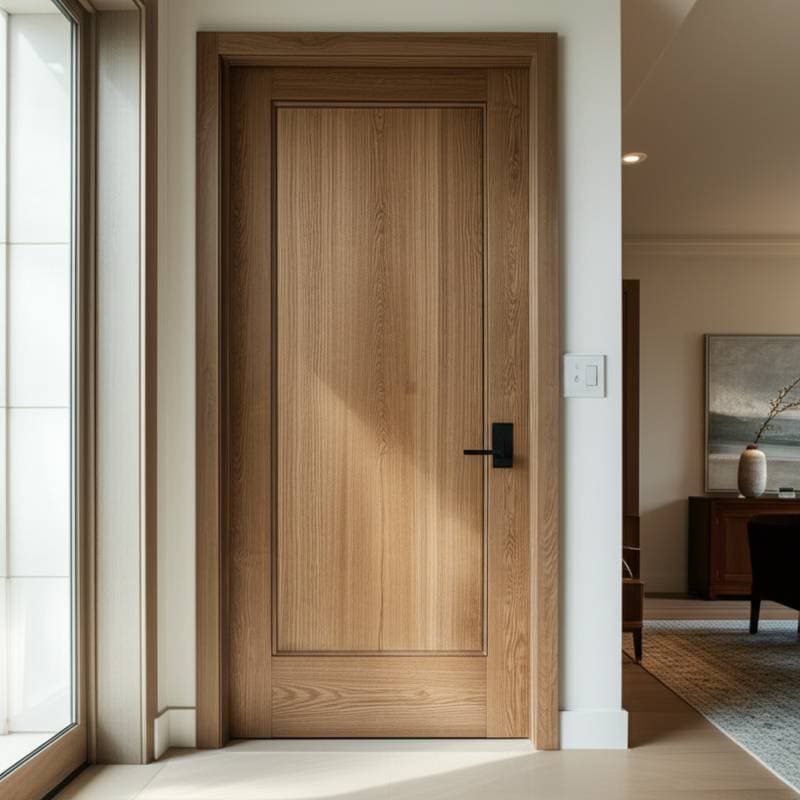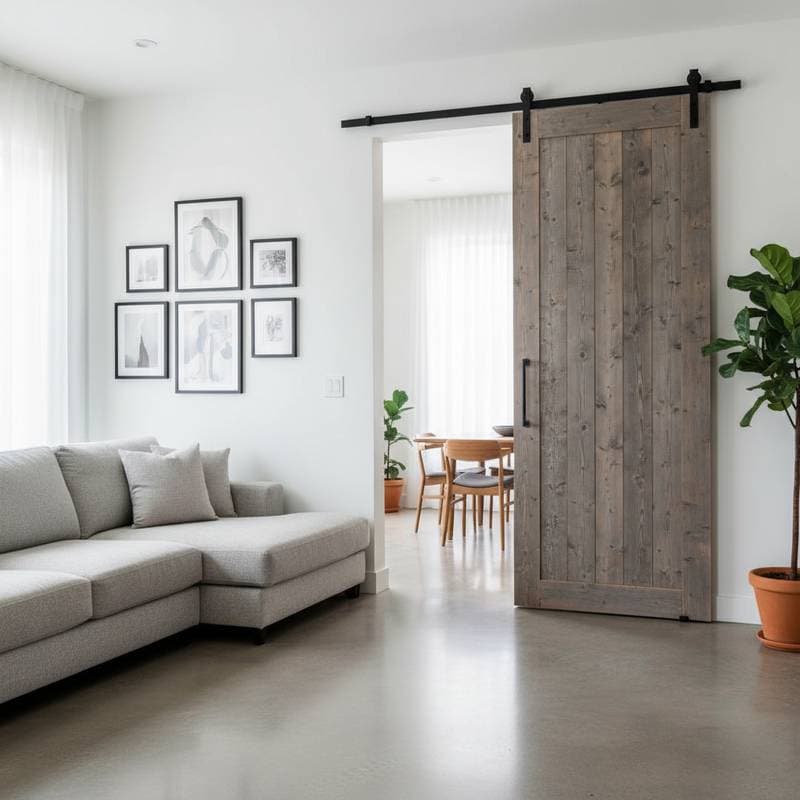Reclaimed Wood Doors: Save 30% vs New
Reclaimed wood doors emerge as a cornerstone of sustainable interior design. These doors infuse homes with historical depth and skilled craftsmanship, alongside tangible financial benefits. Homeowners often discover that reclaimed doors cost about 30 percent less than equivalent new solid wood doors, yet they provide comparable or superior aesthetic charm and structural resilience. The inherent narrative and personality of reclaimed wood surpass what factory-produced alternatives can offer.
Selecting reclaimed wood for interior doors extends beyond adopting a rustic aesthetic. This choice integrates environmental stewardship, reliable performance, and versatile design possibilities. Grasping the lifecycle and preparation of reclaimed materials empowers homeowners to reach informed decisions that align with both functional needs and visual aspirations.
Understanding Reclaimed Wood
Reclaimed wood consists of lumber salvaged from prior uses in buildings like barns, factories, or vintage residences. During deconstruction, workers meticulously recover the wood, then clean and ready it for repurposing. This method safeguards premium hardwoods that would otherwise face disposal.
Through years of exposure, reclaimed wood acquires a distinctive patina unmatched by fresh lumber. Intricate grain formations, subtle nail marks, and tonal shifts reveal tales of endurance and application. Structurally, this wood proves more stable, having endured extensive cycles of environmental stress. Such qualities render it particularly suitable for interior doors, where exact dimensions and alignment prove essential.
Comparing Reclaimed and New Wood Doors
Assessing reclaimed doors against new counterparts requires consideration of multiple elements.
| Option | Initial Cost | Lifespan | Maintenance | Best For |
|---|---|---|---|---|
| Reclaimed Wood Door | Moderate to High | Long | Occasional refinishing | Eco-conscious homeowners seeking character |
| New Solid Wood Door | High | Long | Regular sealing or painting | Those preferring uniform appearance |
| Engineered or Veneer Door | Low | Short to Medium | Minimal | Budget-focused or temporary installations |
Reclaimed doors generally prove less expensive than new solid hardwood doors, though they exceed the price of engineered or hollow-core types. Savings arise from leveraging pre-existing materials, which offsets the extra effort in restoration. This equilibrium of expense and merit positions reclaimed doors as an attractive option for those pursuing premium quality and eco-benefits without the full cost of freshly processed hardwood.
Environmental and Lifestyle Considerations
Repurposing existing wood diminishes the need for fresh timber harvesting, thereby supporting forest conservation and curtailing the ecological toll of extraction and processing. Each reclaimed door signifies reduced carbon emissions, minimized chemical applications in treatments, and decreased landfill contributions.
In terms of daily living, reclaimed wood harmonizes with diverse interior schemes, from classic to contemporary. Finish it sleekly for modern spaces or retain its texture for rustic vibes. The inherent warmth of aged timber fosters an inviting ambiance that artificial substitutes seldom match.
Individuals who prize genuineness value the subtle flaws in reclaimed wood, which impart depth and uniqueness. Since no two boards match precisely, every door installation acquires a bespoke, personal essence.
Assessing Material Quality
Prior to acquiring a reclaimed wood door, inspect the lumber's state thoroughly. Reputable providers scrutinize boards for soundness, excising compromised areas and applying treatments against insects or impurities.
Key evaluation points encompass:
- Moisture content: Ensure the wood dries adequately to avoid distortion post-installation.
- Surface preparation: Verify removal of legacy paint, fasteners, and residues.
- Joint stability: For assembled doors, confirm secure, squared connections.
- Finish readiness: Check that sanding and initial sealing suit intended coatings.
Certain suppliers furnish certifications detailing the wood's provenance. Such documentation affirms ethical procurement and superior caliber.
The Process of Creating a Reclaimed Wood Door
Transforming salvaged lumber into a complete door demands precise, sequential procedures.
1. Planning and Evaluation
Initiate by choosing boards with appropriate thickness and grain aesthetics. Artisans assess compatibility for target dimensions, robustness, and visual harmony.
2. Preparation Steps
Clean each segment to eliminate debris and metallic remnants. Kiln-dry as needed to regulate humidity. Evaluate anomalies like fissures or voids, deciding on repairs or aesthetic integration.
3. Main Implementation
Plane and cut boards, then assemble via time-honored joinery techniques. Incorporate raised, flat, or plank panels per design. Position hardware thoughtfully for seamless future fitting.
4. Quality Assurance
Test fit and equilibrium pre-finishing. Sand to preferred texture, then apply sealants or stains. Opt for oils to accentuate patina or polyurethanes for robust defense in busy zones.
5. Completion and Follow-Up
Post-installation, verify smooth operation via aligned hardware. Regular checks maintain joint integrity and coating efficacy.
Cost Factors and Savings
Reclaimed wood doors yield roughly 30 percent savings relative to new solid hardwood doors. Precise reductions hinge on:
- Source of the wood: Local sourcing cuts transport fees.
- Door complexity: Elaborate carvings or inserts elevate labor.
- Finishing requirements: Ready-to-finish options cost more but streamline setup.
- Condition of the material: Extensive weathering demands added prep, modestly raising expenses.
Overall, reclaimed wood balances economics with artisanal excellence and endurance at accessible rates.
Long-Term Performance and Care
Well-preserved reclaimed wood doors endure for generations. Their acclimated structure withstands moisture and thermal shifts, minimizing distortion risks versus green wood. Sustained upkeep secures this durability.
Essential care practices involve:
- Dusting and mild cleansing with gentle agents.
- Renewing barriers biennially for humidity defense.
- Inspecting alignment to avert friction.
- Repairing abrasions swiftly to halt progression.
With diligent attention, reclaimed wood gains intensified hues and refined surfaces, amplifying visual and emotional worth.
Choosing What Works Best
Deciding between reclaimed and new wood doors hinges on finances, style aims, and future plans. Reclaimed suits sustainability enthusiasts craving narrative, whereas new appeals for consistency or rare species availability.
Weigh these factors:
- Budget priorities: Reclaimed excels in value retention.
- Design intent: It shines in rustic or hybrid settings.
- Maintenance expectations: Embrace periodic touch-ups for lasting allure.
- Environmental goals: Aligns seamlessly with green renovations.
Working with Contractors
Secure artisans versed in reclaimed handling to manage uneven sizes, concealed hazards, and grain variances. Inquire about past reclaimed endeavors and view completed samples.
Installation thrives on dialogue. Double-check dimensions, particularly for legacy frames. Outline finishes upfront, noting wood's unique responses to applications. Partnership yields functional, cohesive results.
Ensuring Quality Results
Homeowners benefit from active oversight. Confirm fluid motion, hardware precision, and uniform treatments.
Extend assurance by allowing finishes to set fully. For doors near exteriors, add seals to boost efficiency and shield against ambient shifts.
Planning for the Future
Reclaimed wood doors transcend fleeting trends. They flex with style evolutions through refinishing. Their resilience supports enduring through successive updates.
Integrating Reclaimed Doors for Lasting Value
Reclaimed wood doors unite fiscal prudence, ecological gains, and design merits into a cohesive package. They curb waste, honor heritage skills, and yield perpetual benefits.
Through process comprehension, integrity checks, and expert collaboration, homeowners gain doors that fulfill utility while evoking heritage. These elements foster sustainable, singular living spaces.






